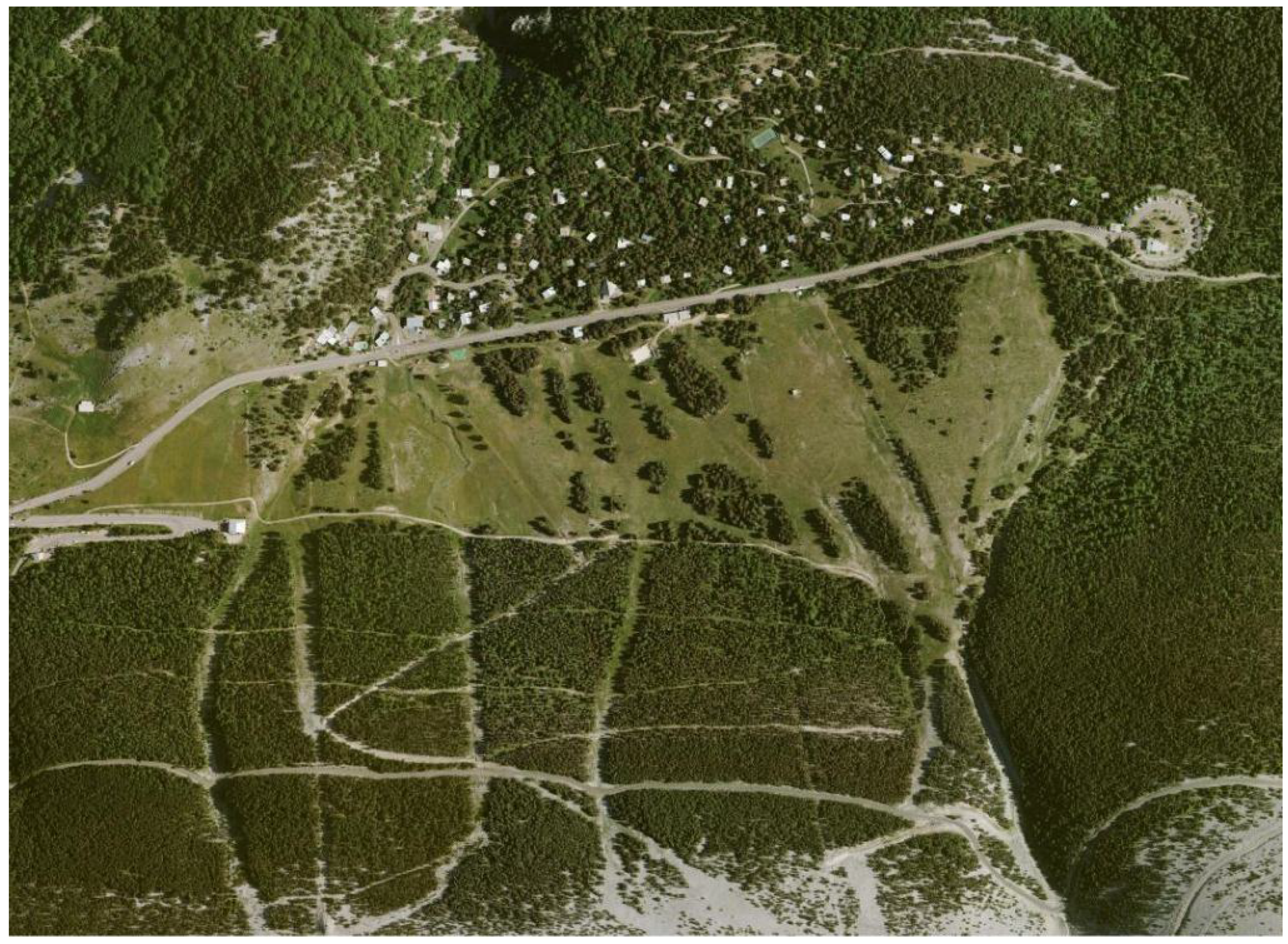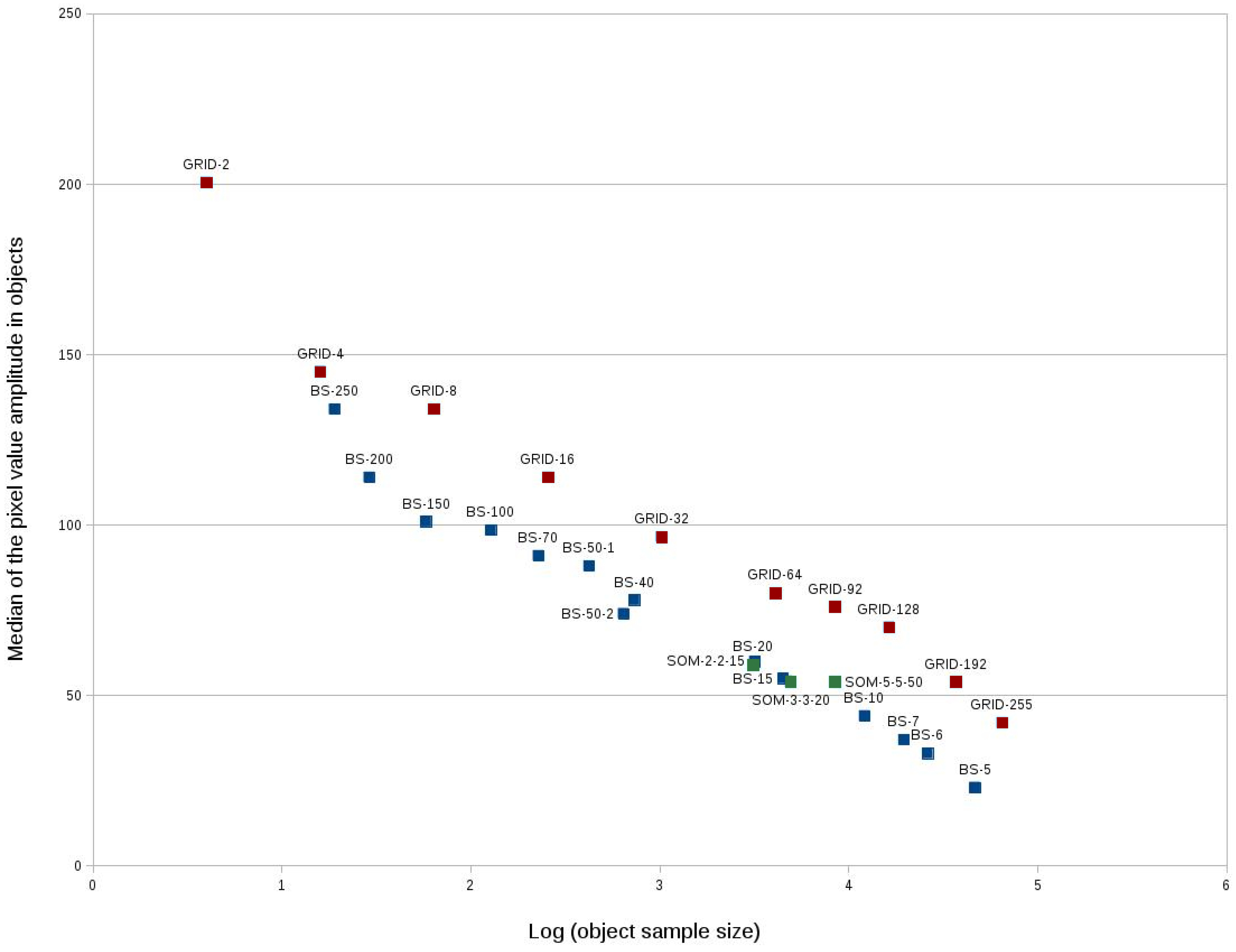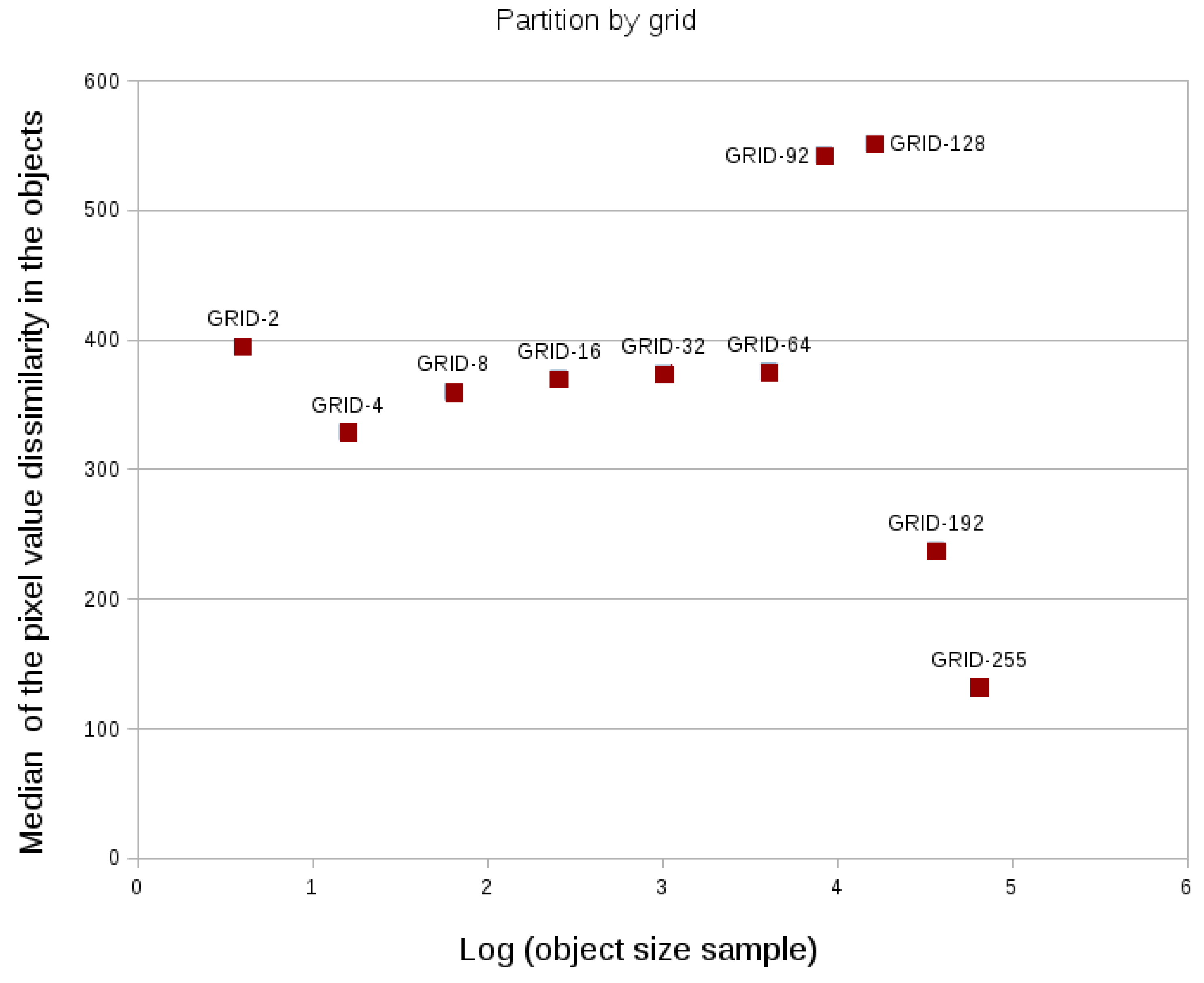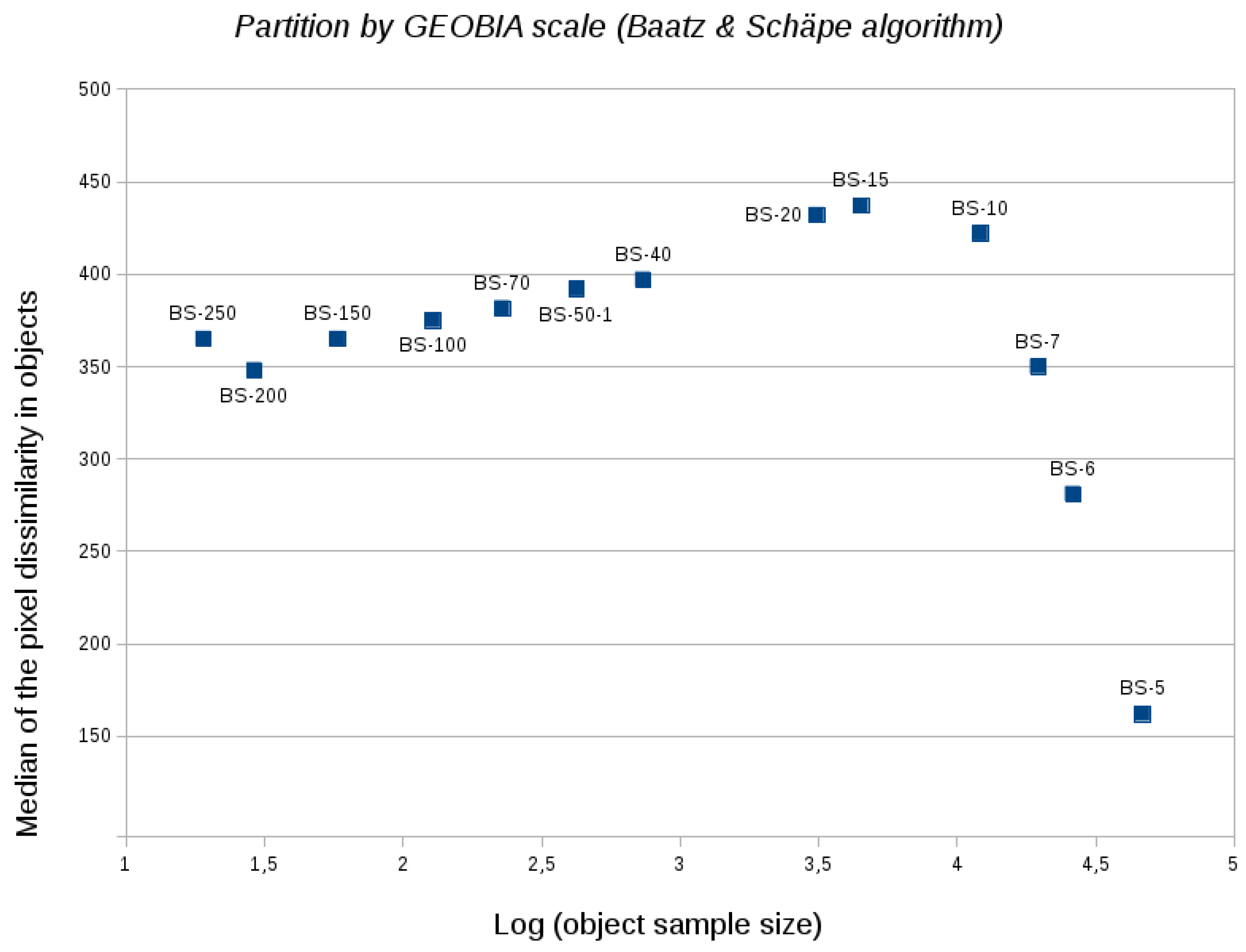Impact of the Scale on Several Metrics Used in Geographical Object-Based Image Analysis: Does GEOBIA Mitigate the Modifiable Areal Unit Problem (MAUP)?
Abstract
:1. Introduction
1.1. The Modifiable Areal Unit Problem
1.2. Relation between Modifiable Areal Unit Problem and Geographic Object Based Image Analysis
1.3. Objectives
- the texture of the objects according to their pixels composition, that deals with homogeneity purpose;
- the shape of objects, that has no concern with homogeneity, but that may help in the readability of the map with non-coarse and compact objects).
- What is the relationship between some of the GEOBIA metrics and scale?
- Is it true that GEOBIA mitigates the MAUP, and, if so, in what way and what extent?
2. Methodology
2.1. Material and Data
- A series of reference non optimized partitions in grids: GRID-N, where N is the number of columns or rows of the grid, with a various quantity of polygon rectangles (2 × 2, 4 × 4, 8 × 8, 16 × 16, 32 × 32, 48 × 48, 64 × 64, 92 × 92, 128 × 128, 192 × 192 and 255 × 255) exemplified by the Figure 3 (GRID-16 with 16 × 16 cells);
- A series of segmentations generated by two GEOBIA algorithms:
- -
- -
2.2. Metrics through Scales
2.2.1. Metrics
- For the pixel statistics on spectral values in the objects:
- -
- Homogeneity of the pixel values in objects (pixel homogeneity in the Grey Level Co-occurrence Matrix, GLCM, [40])
- -
- Dissimilarity of the pixel values in objects (contrast in the GLCM)
- -
- Entropy of the pixel values in objects (Shannon entropy)
- -
- Amplitude, i.e., difference between the lowest and the highest values of the pixels in objects
- For the object shape description:
- -
- Compacity of the polygon, ratio of the area of the shape to the area of a circle (the most compact shape) having the same perimeter
- -
- Ratio perimeter/area of the polygon
- -
- Landscape Shape Index of the object, measure of the normalized patch geometric complexity by a normalized ratio of patch perimeter to area in which the complexity of patch shape is compared to a standard shape (square) of the same size [41]
2.2.2. Image Processing
- Generate a partition with a given method (GRID or GEOBIA algorithm);
- Process the chosen metrics per object (compacity, ratio perimeter/area and shape index) and according to pixels distribution in each object (homogeneity, dissimilarity, entropy and amplitude);
- Get a table with all the statistics of the objects in the partition;
- Map the results in a Geographical Information System (QGIS).
2.2.3. Statistical Analysis
- the median of the object metrics (which summarizes the value of the given metrics in a given scale with a given segmentation method);
- the object sample size according to the series of scales: the sample size increases when the number of the counted objects decreases.
3. Illustration by Maps
- the object compacity on a segmentation using Baatz and Schape algorithm, at scale 70 (Figure 8), with a quantile discretization of the resulting classes,
- the object shape index on a segmentation using Baatz and Schape algorithm, at scale 20 (Figure 9), with a discretization of the resulting classes using equal ranges,
- the pixel value homogeneity on a segmentation generated by a Self Organizing Map (Figure 10), with a quantile discretization of the resulting classes.
4. Statistical Results and Discussion
4.1. Statistical Calculation
- From the statistical table and for all the objects, calculate the global metrics statistics of the objects in the partition; for a given scale and a given partition, the median of each metrics is provided;
- Plot systematically the metrics statistics on the Y axis and the object sample size on the X axis, i.e., the number of polygons in the partition, to emphasize the relationship;
- If it is difficult to graphically separate the different cases from each other, transform the data using a log, that keeps the data sequence monotony and clarifies the points cloud;
- By interpretation, check if there is a gain using GEOBIA and a scale effect or not, by comparing geometrical partitions (grids) to optimized segmentations (GEOBIA).
- blue for BS algorithm results,
- green for the SOM results,
- red for the grid results.
4.2. Global Relationship between Metrics Values and Object Sample Size: Most of the Metrics Are Subject to the MAUP
4.3. Segmentation Improvement by GEOBIA for Some Metrics
- many times, those three cases are overlapped in the plots, meaning that the scale is the most important parameter (for compacity, pixel values amplitude, homogeneity);
- sometimes, color vs shape weights can slightly influence the metrics values: more color improves the ratio perimeter/area and the pixel values entropy, while more color improves the shape index. Nevertheless, this is not very marked.
4.4. Some Non Monotonic Progressions of Metrics Values According to Scale
4.5. Some Cases Where GEOBIA Fails in Finding Better Homogeneous Objects
5. Conclusions
- For a series of metrics (object compacity, ration perimeter/area, shape index and pixel values amplitude), i.e., all the metrics that do not use GLCM including all the shape measures based on object geometry, we can notice the following results:
- -
- for all the scales, there is a (various) improvement of the object compactness and the pixel values deviation inside objects;
- -
- when the object sample size grows through the scales, the slope of the curve drawn by the metrics values follows the shape curve of the metrics values computed in the grids (with a more or less large deviation); even this deviation sometimes increases (e.g., object compacity and especially shape index).
- For the rest of the metrics that use GLCM (homogeneity, dissimilarity and entropy):
- -
- it is not possible to check if using GEOBIA algorithms for partitioning is always determinant in improving those metrics; so surprisingly, there does not seem to be a better homogeneity of the objects in the partitions generated by the GEOBIA algorithms compared to a systematic and arbitrary rectilinear partitioning by a grid, if we consider, as assumed in the introduction, that the better the metrics values, the better the objects detection and the spatial partition;
- -
- more precisely, it seems that when there is an improvement, it highly depends on the scale range (e.g., dissimilarity and entropy).
- On the one hand, mathematically, finding an only example contradicting this conjecture (which is what we have done in this article, even with several cases) is enough to lead to this answer: it is not possible to state in general that GEOBIA segmentation methods mitigate the MAUP, under the assumption that a “better” partitioning is the one that improves the object homogeneity (regarding included pixels).
- On the other hand, we observed that in many cases and for several metrics, especially the ones describing the object shape and compactness (compacity, ratio perimeter/area), using GEOBIA algorithms improved the results. So these approaches are useful, if you consider that getting less coarse and more compact objects helps to make “better” maps, by improving maps readability.
- Moreover, GEOBIA being often seen as an exploratory tool to design a “good” map to delineate and represent spatial objects, we showed that, for some metrics (homogeneity, dissimilarity and entropy), it can be used somehow to look for a (the?) pertinent scale.
Author Contributions
Conflicts of Interest
References
- Openshaw, S. The Modifiable Areal Unit Problem; Geo Books: Norwich, UK, 1984. [Google Scholar]
- Quattrochi, D.A.; Goodchild, M.F. (Eds.) Scale in Remote Sensing and GIS; CRC Press: Boca Raton, FL, USA, 1996. [Google Scholar]
- Sanders, L. Models in Spatial Analysis; ISTE, Hermes Science-Lavoisier: London, UK, 2007. [Google Scholar]
- Royle, J.A.; Dorazio, R.M. Hierarchical Modeling and Inference in Ecology. The Analysis of Data From Populations, Metapopulations and Communities; Elsevier: Amsterdam, The Netherlands, 2008. [Google Scholar]
- Beliakov, G.; Pradera, A.; Calvo, T. Aggregation Functions: A Guide for Practitioners; Studies in Fuzziness and Soft Computing; Springer: Berlin/Heidelberg, Germany; New York, NY, USA, 2007; Volume 221. [Google Scholar]
- Wong, D. The Modifiable Areal Unit Problem (MAUP). In WorldMinds: Geographical Perspectives on 100 Problems; Kluwer Academic Publisher: Dordrecht, The Netherlands, 2004; pp. 571–575. [Google Scholar]
- Robinson, W. Ecological correlations and the behaviour of individuals. Am. Sociol. Rev. 1950, 15, 351–357. [Google Scholar] [CrossRef]
- Langbein, L.I.; Lichtman, A.J. Ecological Inference; Quantitative Applications in the Social Science; SAGE: Beverly Hills, CA, USA; London, UK, 1978. [Google Scholar]
- Pearl, J. Causality: Models, Reasoning and Inference, 2nd ed.; Cambridge University Press: New York, NY, USA, 2009. [Google Scholar]
- King, G.; Rosen, O.; Tanner, A.M. (Eds.) Ecological Inference. New Methodological Strategies; Cambridge University Press: Cambridge, UK, 2004. [Google Scholar]
- Josselin, D.; Mahfoud, I.; Fady, B. Impact of a Change of Support on the Assessment of Biodiversity with Shannon Entropy. In Headway in Spatial Data Handling; SDH’2008, Paris; Springer: Berlin/Heidelberg, Germany, 2008; pp. 109–131. [Google Scholar]
- Bierkens, M.F.; Finke, P.A.; de Willingen, P. (Eds.) Upscaling and Downscaling in Plant and Soil Science; Kluwer Academic Publisher: Dordrecht, The Netherlands; Boston, MA, USA; London, UK, 2000. [Google Scholar]
- Gehlke, C.; Biehl, H. Certain effects of Grouping upon the Size of the Correlation Coefficient in Census Tract Material. J. Am. Stat. Assoc. 1934, 29, 169–170. [Google Scholar]
- Yule, G.U. An Introduction to the Theory of Statistics; Charles Griffin and Cies: London, UK, 1911. [Google Scholar]
- Swift, A.; Liu, L.; Uber, J. Reducing MAUP bias of correlation statistics between water quality and GI illness. Comput. Environ. Urban Syst. 2008, 32, 134–148. [Google Scholar] [CrossRef]
- Arsenault, J.; Michel, P.; Berke, O.; Ravel, A.; Gosselin, P. How to choose geographical units in ecological studies: Proposal and application to campylobacteriosis. Spat. Spatio-Temp. Epidemiol. 2013, 7, 11–24. [Google Scholar] [CrossRef] [PubMed]
- Robinson, A. The Necessity of Weighting Values in Correlation Analysis of Areal Data. Ann. Assoc. Am. Geogr. 1956, 46, 233–236. [Google Scholar] [CrossRef]
- Charleux, L. GWR, MAUP et lissage par potentiels. Rev. Int. Géomatiq. 2005, 15-2, 195–209. [Google Scholar] [CrossRef]
- Holt, D.; Steel, D.; Tranmer, M.; Wrigley, N. Aggregation and Ecological Effects in Geographically Based Data. Geogr. Anal. 1996, 28, 244–261. [Google Scholar] [CrossRef]
- Steel, D.; Holt, D. Rules for Random Aggregation. Environ. Plan. A 1996, 28, 957–978. [Google Scholar] [CrossRef]
- Tranmer, M.; Steel, D. Using Census Data to Investigate the Causes of the Ecological Fallacy. Environ. Plan. A 1998, 30, 817–831. [Google Scholar] [CrossRef] [PubMed]
- Marceau, D.J.; Gratton, D.J.; Fournier, R.A.; Fortin, J.P. Remote Sensing and the Measurement of Geographical Entities in a Forested Environment. 2. The Optimal Spatial Resolution. Remote Sens. Environ. 1994, 49, 105–117. [Google Scholar] [CrossRef]
- Marceau, D.J.; Hay, G. Remote sensing contributions to the scale issue. Can. J. Remote Sens. 1999, 25, 357–366. [Google Scholar] [CrossRef]
- Mahfoud, I.; Josselin, D.; Fady, B. Sensibilité des indices de diversité à l’agrégation. Rev. Int. Géomatiq. 2007, 17, 293–308. [Google Scholar] [CrossRef]
- Josselin, D.; Mahfoud, I.; Fady, B. Analyse exploratoire des effets de support spatial et de robustesse stattistique sur la fiabilité de la mesure de la (bio)diversité. Photo-Interpr. Eur. J. Appl. Remote Sens. 2009, 1, 1–10. [Google Scholar]
- Openshaw, S.; Taylor, P. A Million or so Correlation Coefficients: Three Experiments on the Modifiable Areal Unit Problem; Statistical Applications in the Spatial Sciences; Pion: London, UK, 1979; pp. 127–144. [Google Scholar]
- Hui, C. A Bayesian Solution to the Modifiable Areal Unit Problem. In Foundations of Computational Intelligence; Studies in Computational Intelligence; Springer: Berlin/Heidelberg, Germany, 2009; Volume 2, pp. 175–196. [Google Scholar]
- Louvet, R.; Josselin, D.; Genre-Grandpierre, C.; Ayal, J. Impact des niveaux d’échelle sur l’étude des feux de forêts du sud-est de la France. Rev. Int. Géomatiq. 2016, 26, 445–466. [Google Scholar] [CrossRef]
- Blaschke, T.; Lang, S.; Hay, G.J. (Eds.) Object-Based Image Analysis. Spatial Concepts for Knowledge-Driven Remote Sensing Applications; Lecture Notes in Geoinformation and Cartography; Springer: Berlin, Germany, 2008. [Google Scholar]
- Castilla, G.; Hay, G. Geographical Object-Bassed Image Analysis (GEOBIA): A new name for a new discipline. In Object-Based Image Analysis. Spatial Concepts for Knowledge-Driven Remote Sensing Applications; Lecture Notes in Geoinformation and Cartography; Springer: Berlin, Germany, 2008; pp. 75–89. [Google Scholar]
- Blaschke, T. Object based image analysis for remote sensing. ISPRS J. Photogramm. Remote Sens. 2010, 65, 2–16. [Google Scholar] [CrossRef]
- Blaschke, T.; Hay, G.; Kelly, M.; Lang, S.; Hofmann, P.; Addink, E.; Queiroz Feitosa, R.; van der Meer, F.; van der Werff, H.; van Coillie, F.; et al. Geographical Object-Based Image Analysis—Towards a new paradigm. ISPRS J. Photogramm. Remote Sens. 2014, 87, 180–191. [Google Scholar] [CrossRef] [PubMed]
- Lang, S. Object-based image analysis for remote sensing applications: Modeling reality—Dealing with complexity. In Object-Based Image Analysis. Spatial Concepts for Knowledge-Driven Remote Sensing Applications; Lecture Notes in Geoinformation and Cartography; Springer: Berlin, Germany, 2008; pp. 3–27. [Google Scholar]
- Hay, G.; Castilla, G. Image objects and geographic objects. In Object-Based Image Analysis. Spatial Concepts for Knowledge-Driven Remote Sensing Applications; Lecture Notes in Geoinformation and Cartography; Springer: Berlin, Germany, 2008; pp. 91–110. [Google Scholar]
- Aryal, J.; Josselin, D. Environmental Object Recognition in a Natural Image: An Experimental Approach Using Geographic Object Based Image Analysis (GEOBIA). Int. J. Agric. Environ. Syst. 2014, 5, 1–18. [Google Scholar] [CrossRef]
- Korting, T.S. GEODMA: A Toolbox Integrating Data—Mining with Object-Based and Multi-Temporal Analysis of Satellite Remotely Sensed Imagery; INPE: Sao Jose dos Campos, Brazil, 2012. [Google Scholar]
- Baatz, M.; Schäpe, A. Multiresolution Segmentation—An Optimization Approach for High Quality Multi-Scale Image Segmentation. In Proceedings of the Angewandte Geographische Informations Verarbeitung XII; AGIT: Salzburg, Austria, 2000; pp. 12–23. [Google Scholar]
- Korting, T.S.; Garcia Fonseca, L.M.; Bacao, F.L. Expectation-Maximization x Self-Organizing Maps for Image Classification. In Proceedings of the 2008 IEEE International Conference on Signal Image Technology and Internet Based Systems, Bali, Indonesia, 30 November–3 December 2008. [Google Scholar]
- Korting, T.S.; Fonseca Garcia, L.M.; Câmara, G. A geographical approach to Self-Organizing Maps algorithm applied to image segmentation. In International Conference on Advanced Concepts for Intelligent Vision Systems; Blanc-Talon, J., Ed.; Springer: Berlin/Heidelberg, Germany, 2011; pp. 162–170. [Google Scholar]
- Haralick, R.M.; Shanmugam, K.; Dinstein, I. Statistical and Structural Approach to Texture. IEEE Trans. Syst. Man Cybern. 1973, 3, 610–621. [Google Scholar] [CrossRef]
- Patton, D.R. A Diversity Index for Quantifying Habitat “Edge”. Wildl. Soc. Bull. 1975, 3, 171–173. [Google Scholar]




















| Metrics | Entities | Measure | Requirement |
|---|---|---|---|
| Homogeneity | Pixels | Variability | GLCM |
| Dissimilarity | Pixels | Variability | GLCM |
| Shannon entropy | Pixels | Information | GLCM |
| Amplitude | Pixels | Deviation | Statistical distribution |
| Compacity | Object | Shape | Polygon geometry |
| Perimeter/Area | Object | Shape | Polygon geometry |
| Landscape Shape Index | Object | Patch complexity | Polygon geometry |
© 2019 by the authors. Licensee MDPI, Basel, Switzerland. This article is an open access article distributed under the terms and conditions of the Creative Commons Attribution (CC BY) license (http://creativecommons.org/licenses/by/4.0/).
Share and Cite
Josselin, D.; Louvet, R. Impact of the Scale on Several Metrics Used in Geographical Object-Based Image Analysis: Does GEOBIA Mitigate the Modifiable Areal Unit Problem (MAUP)? ISPRS Int. J. Geo-Inf. 2019, 8, 156. https://doi.org/10.3390/ijgi8030156
Josselin D, Louvet R. Impact of the Scale on Several Metrics Used in Geographical Object-Based Image Analysis: Does GEOBIA Mitigate the Modifiable Areal Unit Problem (MAUP)? ISPRS International Journal of Geo-Information. 2019; 8(3):156. https://doi.org/10.3390/ijgi8030156
Chicago/Turabian StyleJosselin, Didier, and Romain Louvet. 2019. "Impact of the Scale on Several Metrics Used in Geographical Object-Based Image Analysis: Does GEOBIA Mitigate the Modifiable Areal Unit Problem (MAUP)?" ISPRS International Journal of Geo-Information 8, no. 3: 156. https://doi.org/10.3390/ijgi8030156




